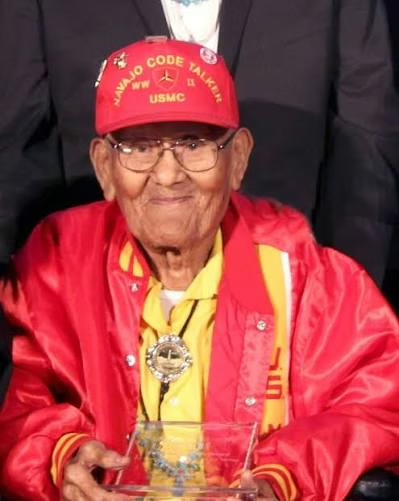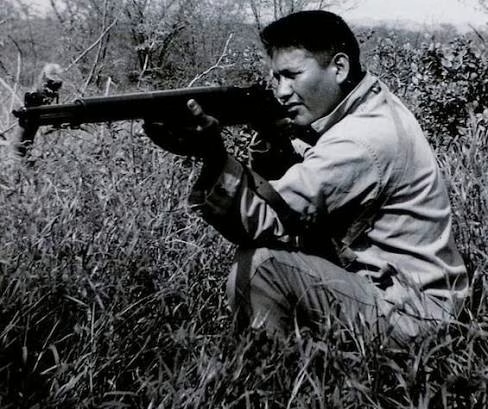
Chester Nez was born on January 23, 1921, in the remote region of Chi Chil Tah, New Mexico, within the Navajo Nation. He belonged to the Dibéłizhiní clan, known as the Black Sheep Clan, of the Tsénahabiłnii, or Sleeping Rock People. The land of his birth was vast, rugged, and unyielding: red mesas stretching toward the horizon, sagebrush whispering in the wind, and the occasional bleat of sheep punctuating the silence. To the outside world, it was desolate; to the Nez family, it was home, a place where traditions and the Navajo language shaped daily life. (en.wikipedia.org)
Nez’s early life was steeped in the rhythms of Navajo culture. He learned to tend sheep under the watchful eyes of his father and grandmother, who instilled in him not just practical skills but the intangible lessons of endurance, patience, and respect for the land. His childhood was punctuated by stories, songs, and the soft cadences of the Navajo language, a tongue passed down through generations but forbidden in many public spheres. (guides.loc.gov)
At the age of eight, Nez was sent to the Bureau of Indian Affairs boarding school at Tohatchi, New Mexico. Boarding schools were part of the federal government’s assimilation policy, designed to strip Native children of their languages and traditions. Children were punished for speaking Navajo, sometimes through physical discipline or the humiliating act of having their mouths washed with soap. For Nez, this was a profound rupture; his voice, the carrier of his heritage, was suppressed daily. (en.wikipedia.org)
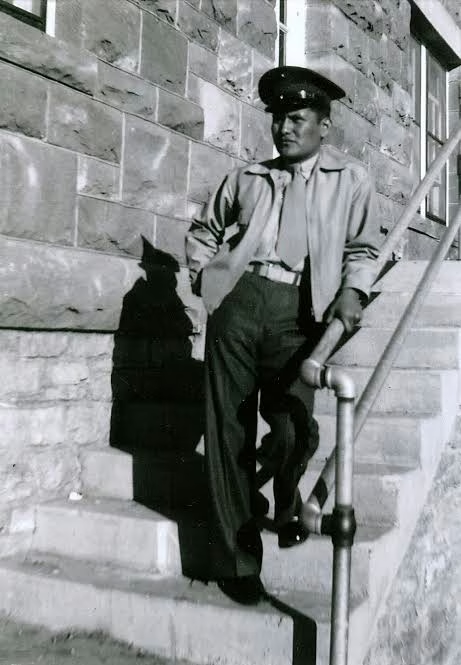
Despite this, he clung to the language of his people in private, memorizing songs, prayers, and the oral history of the Diné (Navajo people). His grandmother, a figure of quiet strength, reinforced these lessons, reminding him that the language was more than words; it was survival, identity, and memory. “Never forget who you are,” she told him. He did not, and that memory would one day transform into a tool of life and war.
Nez also experienced profound personal loss in his early years. His mother died when he was very young, leaving his father, aunt, and grandmother to raise him and his siblings. The family relied on the land and their flock of sheep to survive, a livelihood threatened by federal livestock reduction programs in the 1930s. The government’s program ordered the culling of many animals in the Navajo herds, aiming to reduce overgrazing but devastating families whose wealth and sustenance depended on their sheep. (guides.loc.gov) Nez’s youth was thus marked by both resilience and the recognition of systemic inequities — lessons that would shape his character and sense of duty.
Schooling was harsh, and Nez endured long hours of labor alongside classroom instruction. The discipline of the boarding school instilled obedience and endurance, but it could not erase the cultural imprint of the Navajo language. In secret, he continued to speak, write, and remember the songs and phrases of his childhood. It was a quiet rebellion, a preservation of self in a world determined to suppress him.
As he grew, he felt the pull of the wider world. News of global conflict and the outbreak of World War II reached the Navajo Nation, and young men like Nez were confronted with the complex question of service to a country that had historically marginalized their people. The tension between duty, identity, and survival would soon crystallize in a way that no one could have predicted.
By the time he was 20, Nez had already internalized lessons in patience, observation, and discretion — qualities that would serve him in the military. He knew how to move silently through the land, to read its signals, and to communicate without words if necessary. Little did he know, the language that had been forbidden would soon become a weapon of strategic importance, a shield for thousands of lives, and a testament to the resilience of his people.
Nez’s early years in Chi Chil Tah and at the boarding school had prepared him for more than survival. They had trained him in the discipline of secrecy, in the power of memory, and in the importance of culture as identity. These traits, combined with his natural intelligence and adaptability, would later define his role as one of the original Navajo Code Talkers — a group whose work remained classified for decades, yet whose impact on the war effort was immeasurable.
By 1942, the United States was fully engaged in World War II. The need for secure battlefield communication had become urgent. Traditional military codes were frequently broken by enemy forces, resulting in catastrophic losses. The military sought innovative solutions, and the complexity of the Navajo language presented a unique opportunity. It was a language without a written form, full of subtle inflections, and spoken fluently by only a small population — an ideal foundation for a secure code.
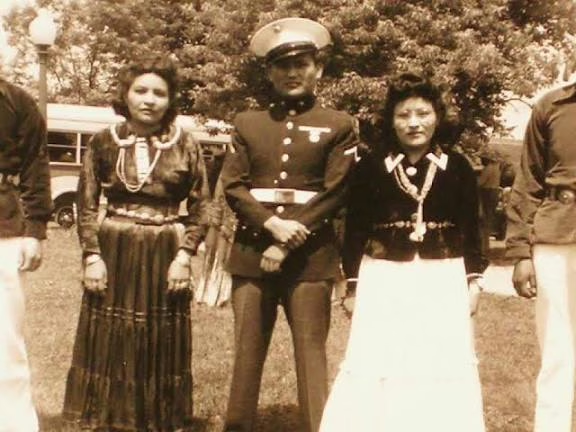
Chester Nez was recruited along with 28 other Navajo men to create and operate this code. Their task was monumental: to transform a living, spoken language into an unbreakable system for transmitting sensitive military information. The irony was profound — the same words that had been forbidden in school would now become a lifeline for soldiers fighting halfway across the world. (guides.loc.gov)
Nez and his fellow recruits understood the weight of their mission, even before their training began. Their work required not only fluency in Navajo but also creativity, precision, and teamwork. They had to develop a system that could quickly encode and decode messages under the pressures of combat, with no mistakes tolerated. Mistakes could cost lives. They also had to endure the rigors of Marine Corps training, a physical and psychological challenge that demanded resilience.
Through the spring and summer of 1942, Nez transitioned from the quiet mesas of New Mexico to the structured discipline of Camp Pendleton and Camp Elliot in California. There, in a mixture of classroom instruction, field exercises, and long hours of memorization, the original Navajo Code Talkers built the first version of the code. They assigned Navajo words to military terms — for example, “turtle” for a tank, “chicken hawk” for a dive bomber — creating a system that could be transmitted by radio and understood only by those trained in it. (en.wikipedia.org)
During these months, Nez’s early experiences — the endurance learned from tending sheep, the discretion instilled by boarding school, the resilience born of personal loss — became invaluable. He memorized hundreds of code words, practiced rapid transmission, and internalized the rhythms of wartime communication. The work was mentally exhausting, yet deeply purposeful. It combined the knowledge of his people with the technical demands of modern warfare, a fusion of tradition and innovation.
As he completed his training, Nez was ready for deployment. The code he helped create would soon be tested in the most dangerous theaters of World War II — Guadalcanal, Bougainville, Peleliu, and Guam. There, the stakes were literal life and death, and the value of the Navajo language as an unbreakable code would be proven repeatedly. (guides.loc.gov)
The transformation of Chester Nez from a boy in the red-dusted mesas of New Mexico into a soldier entrusted with a secret of immense strategic importance was complete. The foundation of his life — language, culture, and resilience — had prepared him for the extraordinary responsibility of protecting countless lives through the voice of his heritage.
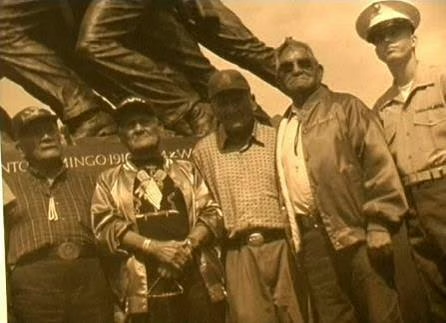
The Call to Serve
In the spring of 1942, the young men of the Navajo Nation, including Chester Nez, were confronted with a choice that seemed paradoxical. The United States had long treated Native Americans as outsiders in their own country, enforcing policies that suppressed language, culture, and identity. Yet now, that very language, which had been forbidden in the classrooms of boarding schools, was being sought as a tool of strategic importance. The Marines believed that the Navajo language could become an unbreakable code, capable of conveying critical battlefield instructions to units across the Pacific. (en.wikipedia.org)
Nez, barely twenty-one, was one of those selected. He did not fully understand the significance of the role at first; he only knew that he was leaving home, leaving the land that had shaped him, to venture into a world of unfamiliar discipline, technology, and danger. Alongside 28 other young Navajo men, he traveled to San Diego, California, where they would begin the transformation from shepherds and students into Marine Code Talkers.
Boot camp at the Marine Corps base was grueling. Nez, like his fellow recruits, faced physical exhaustion, strict schedules, and a relentless push to conform to the rigorous standards of military life. Drill instructors barked commands, enforcing order and obedience, while the recruits struggled to adapt to the rigid hierarchy and unfamiliar environment. The training was designed to strip away individuality and prepare men for the chaos of combat, yet for Nez, his heritage remained intact. The lessons of resilience, patience, and observation from his youth became his armor in this new world.
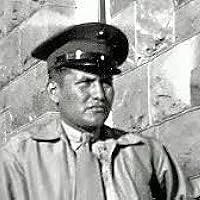
The first weeks tested not only physical endurance but mental fortitude. Waking before dawn, running endless drills, memorizing procedures, and handling the pressures of authority forced Nez to rely on the inner strength cultivated on the mesas of New Mexico. Each morning, the rhythm of camp — reveille, formation, inspection, physical training — echoed the structured life of the boarding school, but with far higher stakes. Mistakes could mean injury, failure, or disciplinary action. Yet Nez pressed on, remembering the quiet discipline his grandmother had instilled, the survival lessons of tending sheep, and the code of respect that governed his people.
After completing basic training, the original Navajo recruits were sent to Camp Elliot, a secluded site in California, to undertake the most critical phase of their mission: developing the Navajo Code. This was a task that demanded not only fluency in their native language but ingenuity, collaboration, and the ability to think in abstract ways under pressure. They were to create a system that could rapidly encode and decode messages in the heat of battle, yet remain utterly incomprehensible to enemy forces.
The first challenge was defining a usable code vocabulary. Everyday Navajo words were assigned to military terms, often using metaphor or analogy. For instance, “turtle” might signify a tank, while “chicken hawk” could represent a dive bomber. Messages were to be transmitted by radio, in voice, at a speed that matched the urgency of combat. Mistakes were unacceptable. Every recruit had to memorize the hundreds of code words, understand their applications, and execute transmissions flawlessly. (guides.loc.gov)
Nez worked alongside his fellow Code Talkers in an environment that combined camaraderie with intense discipline. Long hours were spent practicing transmissions, role-playing battlefield scenarios, and testing the code for clarity and speed. The young men debated word choices, experimented with encoding methods, and corrected errors. Laughter occasionally punctuated the tension, especially when inventive or humorous phrases were proposed for particularly complex military concepts. Yet beneath the levity was a profound understanding of the stakes: each message could influence life or death in combat.
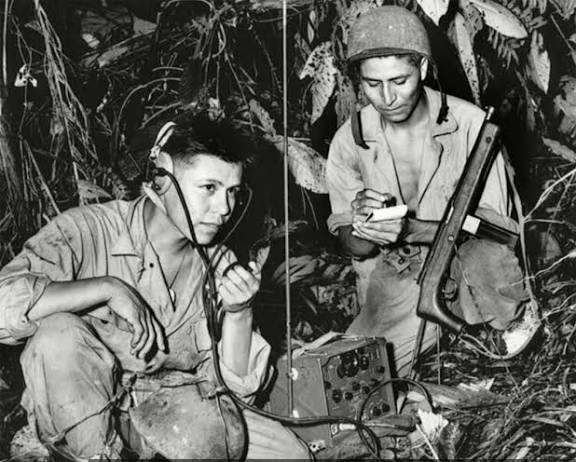
The development of the code also required adaptation to emerging technology. Radio operators were trained to manipulate Morse code machines and field radios, ensuring that the voice transmissions could be sent over long distances with clarity. Nez, who had never handled such equipment before, absorbed the training with meticulous attention, translating his capacity for observation and patience into technical skill. Every flick of the switch, every careful pronunciation of a code word, was practiced repeatedly to ensure precision under fire.
By mid-1942, the first group of 29 Navajo Code Talkers had not only created the basic framework of the code but had also completed rigorous training in both radio operations and battlefield protocols. Nez understood that his role would not only be to transmit messages but also to remain calm under extreme stress, make rapid decisions, and support his fellow Marines. The combination of technical skill, linguistic mastery, and mental resilience set the Code Talkers apart as uniquely capable soldiers in a conflict defined by uncertainty and danger.
Deployment orders soon arrived. Nez and his comrades were sent to the Pacific Theater, where they would face dense jungles, harsh climates, and an enemy determined to disrupt communications. Guadalcanal was their first operational challenge, a site of intense fighting where secure transmission of orders and intelligence was crucial to survival and mission success. Here, the code they had painstakingly developed would be put to its first real test.
Before leaving the United States, Nez reflected on the contradictions of his service. He was fighting for a country that had once sought to erase his language and culture. Yet that same language had become a powerful tool, a shield for thousands of soldiers, and a secret weapon that would shape the course of the war. The irony was not lost on him, and it underscored a profound truth: resilience, ingenuity, and cultural identity could transform oppression into strength.
As Nez and the other Code Talkers embarked on the transport ships to the Pacific, the weight of responsibility settled on their shoulders. They were not merely soldiers; they were keepers of a secret, carriers of a living language that now bore the burden of war. Every transmission would carry the potential to save lives, and every misstep could have dire consequences. Yet Nez moved forward with quiet determination, drawing upon the lessons of his youth — discipline, endurance, and the steadfast connection to his heritage.
The journey across the ocean was long and perilous, filled with the constant tension of enemy attack and the unknown. In these moments, Nez recalled the calm expanses of the mesas, the whispering wind through the sagebrush, and the patience instilled by his upbringing. These memories became an internal anchor, allowing him to navigate the uncertainty of the war zone while preparing to execute his critical role.
By the time the transports reached Guadalcanal, Nez was ready. The weeks of training, coding, and practice had transformed him from a shepherd boy of the Navajo Nation into a soldier entrusted with one of the most important and secretive tasks of the war. The stage was set for the Code Talkers to demonstrate the unprecedented value of their service: a language once forbidden now serving as an unbreakable code, safeguarding lives and altering the course of history. (guides.loc.gov)
Nez’s story in the Pacific was just beginning, but the foundation had been laid. Discipline, ingenuity, and cultural pride would guide him through the trials ahead, shaping him into a soldier whose contributions would remain classified for decades yet whose legacy would endure far beyond the battlefield. In answering the call to serve, Chester Nez would exemplify the power of language, identity, and resilience — a testament to the Navajo people and to the human spirit.
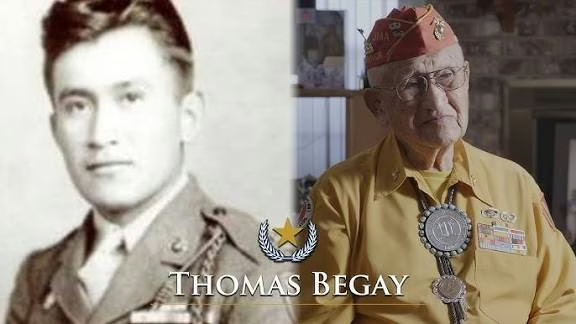
The Code Forged
The work of Chester Nez and his fellow Code Talkers was unlike anything the Marines had attempted before. While the Pacific war raged, they were tasked with constructing a communication system that was both fast and unbreakable. Traditional military codes could be deciphered by the Japanese, often with devastating consequences. The military needed a solution that could endure the chaos of combat, transmit orders quickly, and save lives — and the Navajo language, with its complex grammar, tonal inflections, and unwritten form, offered the perfect foundation. (en.wikipedia.org)
The challenge was immense. The Code Talkers could not simply transmit ordinary Navajo words; they needed a system that mapped abstract military concepts to their language. Nez and the others developed a vocabulary in which specific Navajo words represented military objects, tactics, and locations. A “turtle” might signify a tank; a “chicken hawk” could mean a dive bomber; “iron fish” referred to a submarine. They also used alphabetic substitution, assigning Navajo words to letters for spelling proper nouns, such as place names or ship names. (guides.loc.gov)
Every aspect of the code demanded memorization, precision, and collaboration. Nez spent countless hours with his fellow Code Talkers, rehearsing transmissions, correcting errors, and ensuring that every word could be understood under stress. Their training included simulated combat exercises in which they would encode messages while under duress, racing against the clock to prepare for real battlefield conditions. Mistakes were unacceptable; a single miscommunicated order could result in loss of life.
In addition to mastering the code itself, Nez learned the technical skills necessary for radio operation. Field radios were bulky and temperamental, often prone to interference, static, or breakdown. Code Talkers had to speak clearly, pronounce code words correctly, and listen intently for errors. Nez became adept at manipulating the equipment, ensuring that every transmission was as accurate as possible. The combination of linguistic expertise and technical skill was unprecedented, and it demanded a level of focus and discipline that few soldiers had ever experienced. (en.wikipedia.org)
Beyond the technical and linguistic aspects, the Code Talkers had to develop strategies for maintaining secrecy. The Japanese military was known to intercept communications, and the effectiveness of the code depended entirely on its confidentiality. Nez and his comrades were forbidden from sharing details of their work outside their unit. Even other Marines, including officers, often did not understand the full nature of the code. This secrecy created a bond among the Code Talkers, a shared responsibility that demanded trust, integrity, and vigilance. (guides.loc.gov)
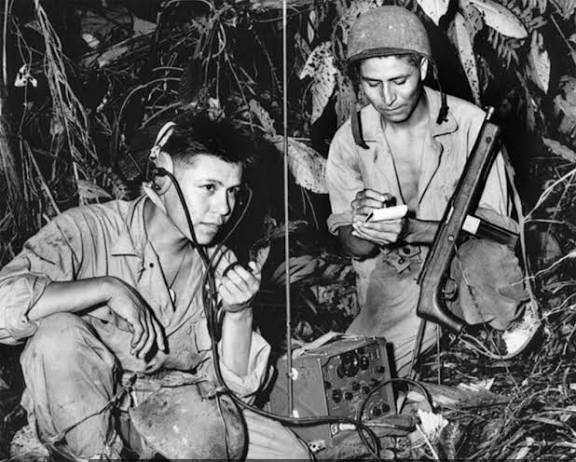
Nez also recognized the symbolic weight of their task. The very language that had been suppressed in school — ridiculed, forbidden, and marginalized — had become a weapon of unprecedented strategic importance. There was a quiet, almost ironic satisfaction in this transformation. The code was a testament to the power of culture, identity, and knowledge passed down through generations. It was proof that the Navajo people, often overlooked or dismissed by broader society, possessed skills that were not only valuable but essential to national security.
The process of developing the code was also deeply personal. Nez drew inspiration from the memory of his parents and grandmother, from the rhythms of the land, and from the oral traditions that had shaped his understanding of language. He treated every code word with care, understanding that precision, clarity, and memorability were critical. A single mispronunciation or misunderstanding could compromise a mission. The stakes were high, and the pressure was constant, but Nez’s upbringing had prepared him to endure both mental and physical stress with composure.
Once the code was sufficiently developed, the Code Talkers engaged in testing and refinement. They ran simulated battle communications, sending messages across mock battlefield networks, timing each transmission to ensure efficiency. Nez often practiced under extreme conditions, simulating the noise, urgency, and chaos of actual combat. Through this training, the code became second nature, a language within a language, capable of rapid, precise communication under fire. (en.wikipedia.org)
By the fall of 1942, the Code Talkers were ready for deployment. The Japanese advance in the Pacific had created an urgent need for secure communications. Guadalcanal, a critical battleground, awaited them. The Code Talkers embarked with a mixture of apprehension and determination, knowing that the lives of their fellow soldiers depended on their skill and discretion. For Nez, the journey was both literal and symbolic: he was leaving the familiarity of training camps and the safety of the United States to enter the uncertainty of combat, armed with a secret only he and his comrades could wield.
On the voyage to the Pacific, Nez reflected on the improbable nature of his mission. The same language that had once been forbidden was now central to the success of military operations. He thought of his youth on the mesas, the lessons of endurance and observation, and the guidance of elders who had taught him the importance of memory and precision. These reflections strengthened his resolve, reminding him that the knowledge he carried was both a duty and a legacy.
The first deployment would test the code and its users under extreme pressure. The jungles, beaches, and mountains of the Pacific Theater were unforgiving environments. Radios would fail, messages would be urgent, and enemy forces would be relentless. Yet the code, developed with care, intelligence, and cultural insight, offered a strategic advantage that could not be matched. Nez and his fellow Code Talkers were not only messengers but protectors, safeguarding the lives of thousands through the careful application of language and memory. (guides.loc.gov)
Through the creation of the code, Nez learned the profound intersection of identity, language, and technology. The work was arduous, mentally taxing, and sometimes monotonous, but it also imbued him with a sense of purpose. Every word, every phrase, and every carefully rehearsed transmission had meaning beyond the immediate task; it represented survival, ingenuity, and the power of a culture long overlooked.
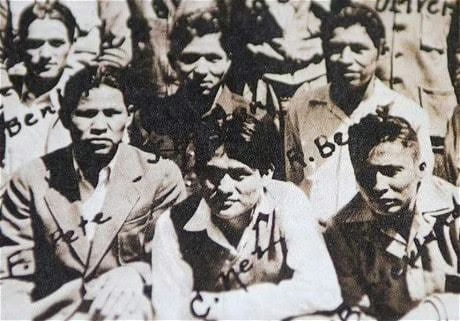
As the Pacific islands drew closer, Chester Nez was ready. He had been transformed by months of intensive preparation into a soldier uniquely equipped to face the challenges of war. The code he had helped forge was no longer an abstract system of words — it was a living tool, a lifeline for soldiers, and a testament to the resilience of the Navajo people. In the coming battles, its value would become clear, and the young man from Chi Chil Tah would stand at the intersection of heritage and history, carrying the voices of his ancestors into the crucible of global conflict.
Fire and Islands
The heat of the Pacific sun was relentless as Chester Nez and his fellow Code Talkers arrived on Guadalcanal in late 1942. The island, a strategic point in the Solomon Islands chain, had already seen months of fierce fighting. The jungle was dense, filled with humidity, mosquitoes, and the constant threat of ambush. The beaches were scarred with bomb craters, the air thick with the acrid scent of gunpowder, salt, and rot. For Nez, the environment was a stark contrast to the open mesas and dry sagebrush of his childhood. Yet, he had been trained to adapt, to observe, and to endure — skills that would now be tested to their limit. (guides.loc.gov)
Upon arrival, the Code Talkers were immediately assigned to front-line units. Their mission was clear: transmit messages that directed troop movements, artillery fire, and naval operations. Every word carried urgency; every transmission could determine life or death. Nez and his partners operated in teams of two, one man sending messages, the other receiving and recording. They became invisible yet indispensable links in the chain of combat command. (en.wikipedia.org)
The work was physically demanding as well as mentally taxing. Radios were heavy and temperamental, often malfunctioning under the heat and humidity. Nez frequently had to climb into makeshift observation points, balancing on uneven terrain, while operating the equipment and speaking in precise Navajo code. Enemy fire was a constant threat. Shells exploded nearby, bullets whizzed through trees, and the screams of the wounded punctuated the air. Amid this chaos, the Code Talkers remained focused, their voices calm, deliberate, and exact. (guides.loc.gov)
Nez recalled one particular mission during the Bougainville campaign. His unit had received orders to coordinate an artillery barrage on an enemy-held ridge. The instructions were complex, requiring precise timing and synchronization across multiple units. Nez and his partner transmitted the messages using the Navajo code, repeating and confirming each phrase to prevent error. When the artillery finally struck, it hit the target with devastating accuracy. The success of that operation was credited not just to the Marines on the ground, but to the invisible work of the Code Talkers — a service that would remain classified for decades.
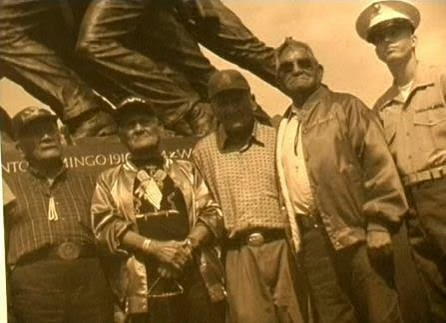
Combat took a psychological toll. Nez saw friends wounded, and in some cases, killed. He learned to compartmentalize fear, pain, and grief, channeling his focus into the task at hand. The code became more than a tool; it was a mental anchor, a framework through which he could exert control in the uncontrollable environment of battle. Even as shells exploded and the earth shook, Nez’s mind remained sharp, articulating code words with precision, ensuring the survival of those depending on his transmissions. (en.wikipedia.org)
The Pacific islands presented other challenges. Disease, malnutrition, and extreme weather compounded the dangers of combat. Jungle terrain was dense and often treacherous, slowing troop movements and complicating logistics. Nez and his fellow Code Talkers had to navigate these conditions while remaining constantly alert, knowing that a single mistake could be fatal. Their discipline, honed through months of rigorous training, allowed them to function under these harsh conditions, maintaining the integrity of the code even when the world around them descended into chaos.
Nez also witnessed the remarkable resilience of his fellow Marines. Despite exhaustion, hunger, and constant threat, the men persisted. This shared struggle reinforced the Code Talkers’ sense of purpose. They were not only transmitting messages but enabling the operational effectiveness of entire units. Their work saved lives, altered the course of battles, and contributed materially to the eventual success of the Allied campaign in the Pacific. (guides.loc.gov)
By the time Nez was deployed to Guam, Angaur, and Peleliu, he had become a seasoned operator. His memory was nearly flawless; the hundreds of code words, the alphabetic substitutions, and the timing of transmissions were second nature. In the heat of combat, he could encode and transmit complex messages in seconds — a skill that astonished his fellow Marines and unnerved enemy forces, who had no way to decipher the Navajo code.
The significance of the code was confirmed repeatedly. Japanese intelligence, despite extensive efforts, never broke it. The secrecy and complexity of the Navajo language, combined with the ingenuity of the Code Talkers, created a communication system that was both efficient and secure. Nez and his colleagues had achieved what had seemed impossible: they had turned their native language into a weapon of war, one that saved lives and preserved strategic advantage in some of the most brutal campaigns of World War II. (en.wikipedia.org)
Yet, even amidst success, the horrors of war left deep impressions. Nez observed the cost of conflict on both soldiers and civilians, the destruction of landscapes, and the indiscriminate toll of artillery and bombs. He learned the fragility of life and the importance of every decision, every transmission. The code, in its precision and reliability, offered a rare measure of control in a world otherwise dominated by chaos.
Nez’s time in the Pacific forged a deep camaraderie among the Code Talkers. They shared experiences that no one outside their unit could fully understand: the stress of rapid transmissions under fire, the knowledge that their work could change the outcome of a mission, and the weight of a responsibility that had been kept secret from the world for decades. Their bond was unspoken, forged in the fires of combat and the quiet understanding that each depended on the other for success and survival. (guides.loc.gov)
After years of grueling service, Nez returned home in 1945, honorably discharged as a private first class. His wartime achievements remained classified, and for decades, the significance of his role went largely unrecognized. Yet the experiences he had endured, the code he had helped create, and the lives he had protected were indelibly etched into his identity.
The Pacific campaigns had tested his endurance, intelligence, and courage. They had transformed a young man from the mesas of New Mexico into a soldier whose contributions would remain a secret until decades later, but whose impact was undeniable. Nez had learned that language, culture, and memory could be as potent in war as weapons of steel — a lesson that would guide him through the postwar years and into the recognition that awaited him in later life.
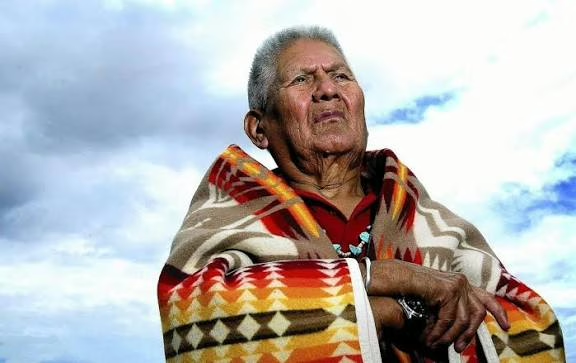
Silence and Return
The guns of the Pacific fell silent for Chester Nez in 1945, but the battle within him lingered. Returning home to New Mexico, he found a world unchanged in its marginalization of Native Americans. The Navajo Nation remained under federal oversight, its people struggling with poverty, displacement, and cultural suppression. For Nez, the transition from soldier to civilian was disorienting. He had spent years under strict discipline, navigating life-and-death scenarios, and carrying a secret of monumental importance. Now, the roar of combat was replaced by quiet mesas and the weight of untold stories. (en.wikipedia.org)
Nez carried the code in his mind, a weapon of survival that had never been disclosed. For decades, he and the other Code Talkers were sworn to secrecy. The military classified their contributions as top secret, preventing them from discussing the code or their missions with anyone, including family. This silence was both protective and isolating. Nez could not speak of his experiences, could not explain the immense responsibility he had borne, and could not share the extraordinary nature of his service. (guides.loc.gov)
He resumed civilian life, initially attempting to pursue education through the G.I. Bill. Nez enrolled at the University of Kansas to study commercial arts, hoping to channel his creativity into a career. Yet, funding limitations and family obligations forced him to leave before completing a degree. The interruption was a reminder of the disparities Native Americans faced in accessing opportunities, even after serving their country with distinction. Despite this setback, Nez never lost his commitment to learning, observation, and personal growth. (en.wikipedia.org)
Employment provided stability but little recognition. Nez worked for decades as a painter at a Veterans Affairs hospital in Albuquerque, a position that allowed him to support himself and his family while remaining connected, in a small way, to the community of veterans. Yet the heroism of his wartime service remained hidden, a secret he could carry with pride but could not publicly acknowledge. The silence weighed heavily, as he observed others honored for achievements while his own contributions went unnoticed. (guides.loc.gov)
In private, Nez reflected on the meaning of his service. The code he had helped create had saved countless lives, a fact he would only later learn through declassified documents and historical research. He recognized that his role in history was extraordinary, even if unrecognized, and he took solace in the knowledge that he had fulfilled his duty with precision, courage, and integrity. The lessons of his youth — resilience, patience, and dedication — continued to guide him through these years of quietude. (en.wikipedia.org)
Family remained central to Nez’s postwar life. He married, raised children, and sought to instill in them the values of their Navajo heritage: respect for the land, commitment to community, and the importance of language and culture. The boarding school experience, once a source of suppression and shame, became a lens through which he emphasized the resilience of the Diné people. He taught his children that identity and culture could be a source of strength, a lesson validated by the critical role the Navajo language had played in the war. (guides.loc.gov)
Despite the imposed silence, Nez found ways to honor his experiences. In the privacy of family gatherings, he would recount stories of perseverance, bravery, and cultural pride, carefully avoiding classified details. These recollections became a form of quiet preservation, ensuring that the legacy of the Code Talkers endured even before public recognition was possible. He remained committed to his community, participating in cultural events, mentoring younger generations, and preserving the oral traditions that had shaped his life. (en.wikipedia.org)
The 1960s and 1970s brought social change across the United States, including growing awareness of Native American rights. While the Code Talkers’ contributions were still classified, Nez observed a broader recognition of the injustices faced by his people. Activism and legislation began to address systemic inequities, and the Navajo language gained renewed attention as a cultural treasure. For Nez, these developments reaffirmed the value of what he had long known: that culture, language, and identity were powerful forces capable of shaping history in ways beyond immediate comprehension. (guides.loc.gov)
The decades of postwar silence were also a period of reflection. Nez understood that the recognition of his service, while delayed, was inevitable. The declassification of the Navajo code, occurring gradually in the 1960s and 1970s, allowed historians and the public to begin understanding the profound impact of the Code Talkers. Nez, along with his fellow veterans, witnessed the transition from obscurity to acknowledgment, a transformation that validated the sacrifices they had made and the critical role of their language and culture in military history. (en.wikipedia.org)
Throughout these years, Nez maintained a sense of humility. He rarely sought attention or accolades, viewing his service as a duty rather than an opportunity for fame. Yet the significance of his work grew in historical perspective. The Code Talkers had preserved lives, altered the course of battles, and contributed to the ultimate success of Allied forces in the Pacific. Nez’s own contributions, though invisible to the public, were foundational to this achievement.
By the 1980s and 1990s, as the Code Talkers began to receive recognition, Nez reflected on the long arc of his life. From the red mesas of New Mexico, through the rigors of boarding school, the crucible of combat, and the decades of silent service, his journey embodied the resilience of the Navajo people. The language that had once been suppressed was now celebrated for its role in history, and the values instilled in him during his youth had guided him through every challenge. (guides.loc.gov)
Nez’s postwar years demonstrated that heroism was not always measured in medals or public acclaim. Sometimes, it existed in quiet perseverance, in living with integrity and purpose, and in carrying a legacy that would only be fully understood decades later. The code, the battles, and the sacrifices of the Pacific were deeply interwoven with his sense of self, forming a narrative of resilience, service, and cultural pride.
In these decades, Chester Nez became a bridge between generations. He nurtured his family, supported his community, and embodied the principles of his heritage. Though his role as a Code Talker remained largely hidden, the impact of his work would eventually reach beyond his lifetime, educating the world about the unique contribution of the Navajo people to global history. (en.wikipedia.org)
The Long Echo
By the early 2000s, the world had finally begun to recognize the extraordinary contributions of Chester Nez and his fellow Navajo Code Talkers. After decades of silence, the code that had safeguarded countless lives was no longer secret, and the public could appreciate the ingenuity, courage, and cultural significance of these men. For Nez, recognition was bittersweet; it arrived late in life, yet it validated the sacrifices, discipline, and resilience that had defined his journey. (en.wikipedia.org)
In 2001, Nez was awarded the Congressional Gold Medal, one of the highest civilian honors in the United States. President George W. Bush presented the award to him and four other living Code Talkers, acknowledging their critical role in World War II. The ceremony was poignant, a public acknowledgment of a service that had long been hidden, and a moment in which Nez’s work and heritage were celebrated simultaneously. For him, it was not just a personal honor, but a tribute to the Navajo people and the enduring value of their language. (guides.loc.gov)
Following the recognition, Nez took steps to ensure that the history of the Code Talkers would be preserved for future generations. In 2011, he co-authored his memoir, Code Talker: The First and Only Memoir by One of the Original Navajo Code Talkers of WWII, with Judith Avila. The book provided a rare glimpse into the life of a man who had lived in silence for decades, offering both historical documentation and personal reflection. Through his memoir, Nez conveyed not only the technical and strategic aspects of the code but also the cultural and emotional dimensions of service, survival, and identity. (en.wikipedia.org)
The memoir became a bridge between the hidden history of World War II and contemporary understanding. Readers learned about the challenges of developing the code, the intensity of combat in the Pacific, and the psychological burden of secrecy. They also gained insight into the Navajo culture that had made such a code possible: its linguistic complexity, its emphasis on memory and oral tradition, and the resilience instilled by generations of life on the mesas and in the deserts of the American Southwest.
Nez’s story resonated far beyond the military community. Schools incorporated his memoir into curricula, museums created exhibits about the Code Talkers, and documentaries highlighted the crucial role that Native American culture had played in global history. His life became a lens through which to understand not only World War II but also the broader struggle for recognition, respect, and equality faced by Native Americans throughout the twentieth century. (guides.loc.gov)
Even in recognition, Nez remained humble. He often emphasized the collective nature of the Code Talkers’ accomplishments. “I was one of twenty-nine,” he reminded interviewers, downplaying the spotlight on himself. His focus remained on the language, the culture, and the bonds formed with his fellow Code Talkers — men who had risked everything and whose courage and ingenuity had saved lives in ways that would only later be understood. The story was never about a single individual but about a community, a people, and a heritage that had shaped history. (en.wikipedia.org)
In his later years, Nez continued to advocate for the preservation of the Navajo language and culture. He understood that the power of language was not merely historical but ongoing. Just as the code had preserved lives during World War II, the language itself preserved identity, memory, and resilience. He encouraged younger generations to learn and speak Navajo, to honor their heritage, and to recognize the strength embedded in culture and community. (guides.loc.gov)
Chester Nez passed away on June 4, 2014, in Albuquerque, New Mexico, at the age of 93. His death marked the end of a chapter in history — the last of the original 29 Navajo Code Talkers. Yet his legacy was far from over. The impact of his life reverberated through history books, classrooms, military archives, and the memories of those whose lives he had helped protect. He left behind a narrative of courage, innovation, and cultural pride that continues to inspire. (en.wikipedia.org)
The story of Chester Nez illustrates the intersection of culture and history, of identity and service. From the red mesas of New Mexico to the battle-scarred islands of the Pacific, his life embodied the extraordinary potential of ordinary people when shaped by discipline, heritage, and purpose. The Navajo Code Talkers demonstrated that language could be a weapon, culture could be a shield, and resilience could transcend adversity.
Today, museums and memorials honor the Code Talkers. Students study their contributions. Military strategists analyze their work. Scholars explore the linguistic and cultural dimensions of the code. Yet beyond these external recognitions, the true legacy of Chester Nez lies in the enduring power of the Navajo language, the cultural pride he instilled in his descendants, and the knowledge that a young man from a remote corner of New Mexico could change the course of history through intellect, courage, and the voice of his people.
In reflecting on his life, one sees the continuity of tradition and innovation. Nez’s journey — from childhood under the vast skies of the Southwest, through the rigors of boarding school, the discipline of the Marines, and the chaos of war — was a testament to human endurance and ingenuity. The Navajo language, once suppressed, had become a lifeline, a secret weapon, and ultimately a celebrated heritage. Nez’s story serves as a reminder that the ordinary can be extraordinary when guided by courage, intellect, and a deep sense of identity.
The life of Chester Nez also reminds us that heroism often exists in silence. For decades, the Code Talkers’ contributions were unknown, their work invisible to the broader world. Yet their impact was profound, saving countless lives and shaping the outcome of critical battles. Nez carried this silent heroism with humility, never seeking fame but always honoring the language, culture, and people that had shaped him. In doing so, he created a legacy that transcends time, war, and geography.
As history remembers Chester Nez, it is not merely as a soldier or a code operator, but as a living embodiment of the resilience of the Navajo people. He demonstrated that knowledge, tradition, and culture are powerful tools in shaping history. Through his life, future generations learn that identity is not a limitation but a source of strength; that language is not just communication but survival; and that courage is often quiet, enduring, and transformative.
Chester Nez’s story is a testament to the invisible threads that connect heritage, duty, and human ingenuity. The mesas of New Mexico, the radios of the Pacific, and the voices of soldiers on distant islands all converge in the narrative of one man whose life demonstrates the extraordinary potential of culture, language, and resilience. His legacy is permanent, woven into the history of the United States, the memory of World War II, and the enduring story of the Navajo people.
And so, as the world continues to honor the Navajo Code Talkers, the life of Chester Nez stands as a silent echo — a reminder that courage, intellect, and cultural pride can change the course of history. The code he helped create, the battles he endured, and the decades of quiet service all bear witness to the profound impact of one man, one language, and one people in the fight for freedom, survival, and recognition. His voice, once secret, now resonates across generations, carrying the lessons of endurance, ingenuity, and the power of identity for all time. (en.wikipedia.org)
